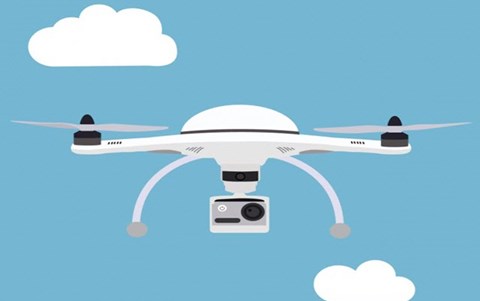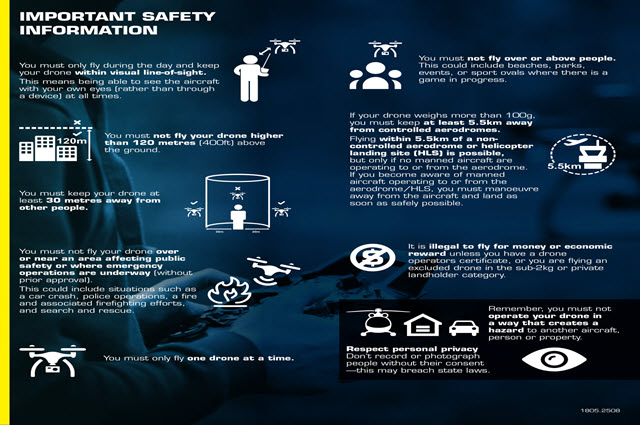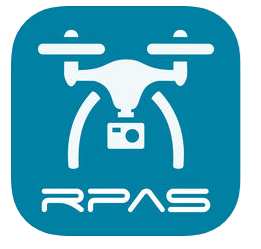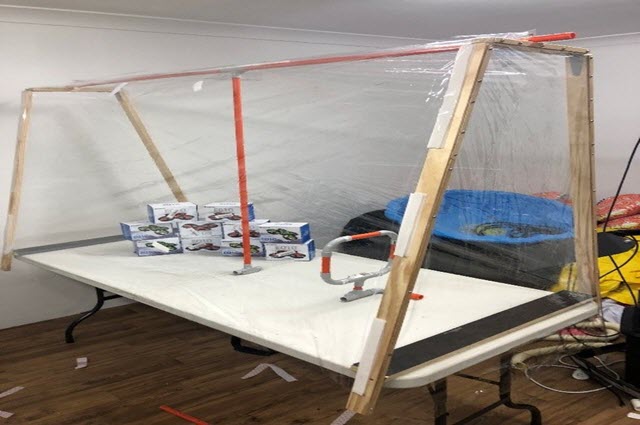Clayfield College's Drone Club
Introduction
The new Australian Curriculum: Digital Technologies curriculum offers the exciting opportunity to teach digital content in new and innovative ways. One example of this is through the study of drone technology, along with the topics of augmented reality, virtual reality, website development, and game development.
Drones seem to be everywhere at the moment. Their application across commercial industry is appears to be endless, and they are also employed in ways that can enhance and even save lives. Given drones’ wide application, many schools have already started to explore how they can be used within an educational context, to teach students computational thinking and problem solving.
However, allowing students to build and code a digital solution using drone technology is both an exciting and daunting prospect for most Digital Technology teachers. From a school perspective, despite the opportunities drones offer for new and exciting ways for students to engage with the Digital Technologies curriculum, they also provide logistical challenges. These include issues such as safety (for students and staff), meeting strict government rules around where and when drones can be flown and, not least, having teaching staff on hand who are confident and willing to deliver a drone unit that is more than just ‘fun’ and is comprehensively aligned to the curriculum in meaningful ways.
But introducing drones into school curriculum is possible. If planned and researched carefully, a drone unit can meet all the necessary content standards and descriptors set out by the Australian Curriculum, Assessment and Reporting Authority (ACARA). It can also make the implicit learning ‘fun’.
Why start a drone club?
After much research and discussion with other parties, Clayfield College decided to do this via the creation of a ‘Build to Fly’ drone club. By introducing drones into the school via a club, the early concerns around having robust assessment and alignment with the Australian Curriculum could, the college believed, be offset, at first, at least. Nevertheless, Clayfield realised that there was also an initial cost in setting up a drone unit, so money would need to be spent wisely.
The college believed that, as mentioned above, starting with a drone club before taking the step toward an in-class project would allow it to explore some of the issues around using drones with students, such as safety, cost, physical handling and storage.
But where to start setting up a drone club? See the list below of some of the key issues Clayfield College experienced with setting up one up within a school setting, and provided some key tips for any schools wishing to do the same thing in their setting.
Getting started
Step 1 – Decide on the club’s purpose
Obvious as it may sound, it is really important to work out early on what you want to achieve. There are lots of different drones on the market, and you will need to do your research before you commit to buying anything. Drones are also expensive kit to buy. So, thinking about what you want to achieve with your club is a vital part of working out what drones to purchase. Do you want to:
- use drones predominantly to teach programming
- learn about how drones work
- use drones for project-based problem solving
- or just fly the drones for a bit of fun – using them only for flying?
At Clayfield College we wanted to create more than just a club to fly drones. We wanted a club that would also allow our students to explore how drones work, and give them the opportunity to problem-solve too. For that reason, it was decided to invest in the Build to Fly drone kits from JAR education. (You may have your own preferred retailer.) These kits would enable the students to program and fly drones, and give them real hands-on experience in constructing their very own drone. Purchasing the kits also gave access to JAR’s LMS (learning management system – Canvas) which allowed the students to build the drones at their own pace, while providing them with guided tutorials. The included resources were invaluable to the smooth running of the club.
Step 2 – Decide what size drones to buy
Generally, the bigger the size of the drone, the more it can do. For example, carrying cameras and picking up objects typically require more expensive, larger drones. However, size also impacts on the safety regulations around flying drones. It is therefore important to put some thought into the size of the drones you buy.
If you’re not sure what size drones to buy, it might be worth considering whether to buy more than one type, which would enable your students to engage with drones of different sizes and capabilities and help you figure out the size that best suits your needs. This is a particularly useful idea if your club is going to include students from a wide range of year levels and capabilities.
Purchasing some micro-drones or mini-drones initially (and using those to teach the students some of the basics of flying) is a good hook to keeping them interested in the club. Plus, they are a lot of fun and relatively cheap to buy. If you do go down the smaller drone route to begin with, be mindful they may have little or no programming capability, though enjoyable for students to use.
Drone equipment can be expensive to buy, and can become obsolete quickly. The Mambo Parrot drone could be a good lower cost starting point if you are new to drones and wish predominantly to focus on giving your students ‘flying’ exposure. Many companies provide teacher professional development (PD) and training with these drones. They are indoor flight drones only, so are a good option for a lot of schools.
These small drones can be coded fairly easily by using the block coding language Tynker.
Level of coding challenge
Drones that can be block coded are ideal for engaging primary or middle-school students. For older students, you will probably need something more challenging and bigger in size – more than likely one that can be coded using a general-purpose text-based programming code like Python (as per the Digital Technologies syllabus guidelines).
Storage and flying time
If you intend to build and fly drones, you will need adequate space to store them. Another useful tip to remember is that drone flight time is usually very short – for smaller drones it can be only five to seven minutes. Therefore, a good tip is to buy an extra set of batteries for your drones, or chargers, so that your students have more flight time available to them.
Clayfield College’s decision
We decided to purchase two types of drones for the club:
- the h46 Micro drone (for fun, to engage students)
- four Build to Fly drone kits from JAR aerospace, through their arm JAR Education. (You may have an alternative retailer that you prefer to use.)
We split students into groups of four to five, and each group was given a kit to build. JAR education provide all the necessary instructions and learning material through their learning management system, and charged a licence fee to access it.
Step 3 – Consider safety concerns
The safety around flying drones is probably the single biggest concern (and obstacle) for schools looking to introduce drones – and for good reason. There are strict rules around flying drones and, if you are located close to an airport, the rules are even stricter. See the CASA (the Civil Aviation Safety Authority) website, which has lots of important and practical advice about flying drones for fun/recreation:
Flying your drone for fun brochure (PDF 583.29 KB)
The location of your school will dictate whether or not you can fly drones outdoors in your school, for example over the school oval and playing grounds. But there are still many options available for indoor drone flight, so a location problem doesn’t necessarily mean you are not able to fly drones at all.
Important safety rules to address early on in your drone research:
Is your school able to fly drones within its boundaries?
See CASA – Civil Aviation Safety Authority.
If your drone weighs more than 100 g, you must keep at least 5.5 km away from controlled aerodromes.
Despite proximity to Brisbane airport, Clayfield College is actually 6.8 km from Brisbane airport, so the school is permitted to fly drones outdoors on school land.
Here is a recap of CASA’s nine drone rules. The drone:
- must only be flown during the day and must be visible to the operator
- must not fly higher than 400 ft (120 m) above ground level
- must not be flown above people
- must be kept 30m away from other people
- must not be flown near an area where there are emergency operations being performed
- must only be flown one at a time, per person
- must not be flown within 5.5 km of a controlled aerodrome, and only when there are no other aircraft present at an uncontrolled aerodrome
- must be flown in such a way that it does not create a hazard
- must be flown with respect for personal privacy.
While these rules may seem restrictive and difficult to remember, CASA is making them more accessible through their droneflyer initiative. You can visit their web page and complete the rules and regulations quiz at the bottom.
CASA also has an application called Can I Fly There?.
It is available through most app stores and an online version is available through the link below:
Can I Fly There? – CASA’s flight map application
It is also important to explain to the students early (at the first club meeting) all of your expectations and rules, which should also be in line with any specific school regulations.
Step 4 – Purchasing your drones
Many businesses sell drones, and it really does pay to shop around to find the best price for your budget. The drone kits we used at Clayfield College can be purchased through JAR Education for around $800 per kit, but these drones can be built, flown and then stripped down and built again.
At Clayfield, we also purchased three h46 Microdrones through GearBest for around $20 each, and additional batteries for between $3.00 and $8.00 each. (These are also relatively inexpensive and worth the investment.) It is also worth purchasing a multi-charger, so that you can have of the drones charging easily at the same time. The students have really enjoy playing with these and it is a great way to break up the intensity of building the drones!
You may also find some good deals with some of the electrical stores like Harvey Norman and Dick Smith.
These drones require some building:
Further observations and tips
- Try to limit the club members to around 15. You will lose some students as time goes by, but if the club’s too big you will not be able to offer one-to-one help.
- Many students will sign up for the club because they just want to fly drones. I found that I lost around half of the students after a couple of weeks because they found the building process dull or too hard. Allowing students to continue to fly the microdrones through the building process is important (particularly for the younger students).
- Be clear to students in the club about what they will be doing – flying or building, or both, and when.
- Encourage independent working and problem solving in small teams. Resist the temptation to do everything for them.
- Have at least two adults /teachers present during the club. Depending upon numbers, you may need more. (Also, be aware of when non-teachers need a Working with Children Check). Students frequently need the one-to-one help, and it is good to give them this support as much as possible.
- Hold the club in as bigger room as possible to allow club members to fly the smaller drones indoors. Allowing them to fly the drones outside means a higher chance of losing or breaking them.
- There are some great blogs and there is plenty of advice around from other teachers. Try to tap into this if you can.
- Create a fly space!
A very small and safe fly space! (courtesy of @myDTech)
Student reflections
Watch Jennifer and Merin's reflections on the implementation of a drone club in their school.
What interested you about joining the drone club in your school?
What do you think you have learnt through building your drone?
What does the drone club offer you that class does not?
Would you recommend the club to students? Including girls? Why/why not?



